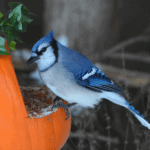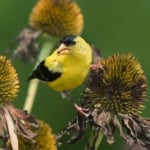Lily Of The Valley The May Birth Flower
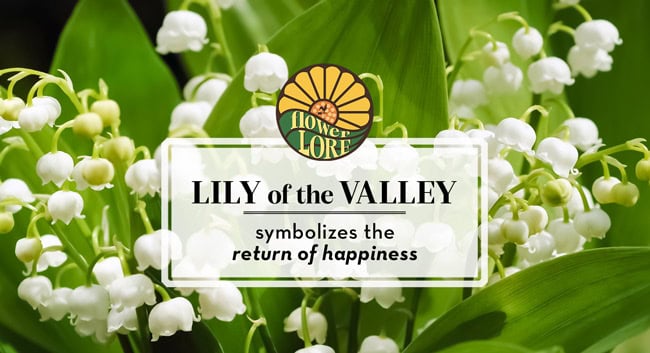
Lily of the valley is a sweet, nostalgic flower that typically thrives during the rich spring conditions of May. These clumping blooms sprout their delicate bell-like blossoms throughout the month, making them a lovely choice for the May birth month flower. But how much do you know about lily of the valley meaning and the alternate May birth flower, hawthorn? Both have unique histories filled with unexpected lore.
Jump to Lily Of The Valley Meaning
About Lily Of The Valley
Lily of the valley (Convallaria majalis) is an herbaceous perennial found naturally in temperate northern woodlands and forests, with three different geographic subspecies in its native ranges of North America, Europe, and Asia. A member of the plant family Asteraceae, lily of the valley is related to asparagus, hosta, yucca, agave, snake plant, and spider plant.
These sweet-scented blooms have bell-shaped flowers on thin sprays, with clumping foliage providing a luscious green base. Depending on the variety, the leaves may be a rich, deep green (similar to the May birthstone, emerald), blue-green tones, or lighter variegated striping. Different types may also have double blossoms.
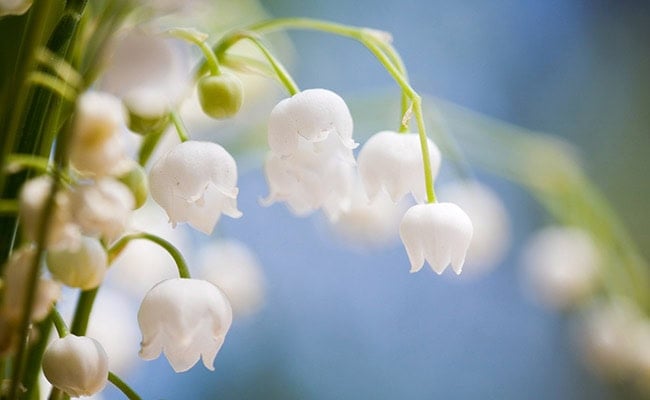
White or light pink blooms with scalloped edges flower in late spring, from as early as late March in mild winters and through May, making them ideal as the May birth month flower. In fact, lily of the valley is sometimes also called May bells or May lily, showing their connection to the fifth month of the year. Even the flower’s Latin name, Convallaria majalis, translates to “valley lily of May” or similar variations. Other names for these flowers include glovewort, Our Lady’s tears, Mary’s tears, ladder-to-heaven, and fairy bells.
In the fall, lily of the valley produces small orange-red berries, and while the foliage may die off over the winter, these are hardy plants that may return for many years.
Related product: May Birthstone – Blue Lace Agate
Lily Of The Valley Symbolism
Lily of the valley has many symbolic meanings—from serenity, purity, and innocence to humility, humbleness, and freshness. These blooms may be used to denote youth as well as rebirth and rejuvenation but are also known to symbolize tears and mourning.
Joy, a return of happiness, and sweet love are part of lily of the valley’s definitions in floriography, the language of flowers, popular in the Victorian era, and those meanings still hold today. In fact, these flowers are often favored for bridal bouquets because of their symbolism of joy, good fortune, purity, innocence, and other qualities associated with young love and weddings.
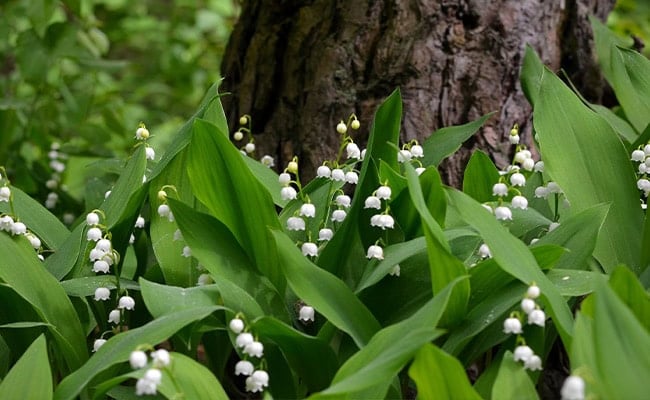
Catherine Middleton, Princess of Wales, carried a bouquet of lilies of the valley during her 2011 wedding to Prince William, and other royalty—including Queen Victoria, Princess Astrid of Sweden, and Princess Grace of Monaco have also used lilies of the valley in their bridal bouquets. In another royal connection, these flowers are reputed to have been the favorite of the Queen Elizabeth II.
Even more symbolism for these blooms can be found in dreams. Depending on the context of the dream sequence, the flower may mean joy or success, could foretell good fortune or the receipt of a gift, may be an omen of good news, or might symbolize less positive emotions such as worry or exhaustion.
Lily Of The Valley Meaning Around The World
Lily of the valley flowers are found in the folklore of many cultures. Ancient Greek legends attribute the origin of lily of the valley to Apollo, son of Zeus and the god of healing, music, archery, poetry, and truth, who created the sweet flowers as a ground cover for nymphs to walk upon.
Christian folklore, on the other hand, mentions lily of the valley in various ways. The flowers are one of several said to spring from the tears of the Virgin Mary as she wept at the base of the cross after Jesus’ crucifixion, hence the names Our Lady’s tears and Mary’s tears for these flowers.
The sweet scent of the blooms is considered representative of the sweetness of Jesus’ teachings and is even associated at times as a sign of Christ’s second coming. Another variation of the Christian origin of these flowers is that they were created by Eve’s tears as she and Adam were expelled from the Garden of Eden.
Any questions? Contact [email protected]
In Norse, Anglo-Saxon, and Celtic legends, lily of the valley is sometimes associated with the virginal Ostara, the goddess of spring and the spring equinox, also known as Eastre and Eostre (variations of Easter).
In France, these flowers are celebrated on May 1 as a symbol of spring and good fortune, a custom that originated in 1561 during the reign of King Charles IX when he received a sprig of the delicate blooms as a gift for good luck. He was so charmed that he began a tradition and presented bouquets of the flowers to the ladies of his court every May 1. The custom became even more widespread in the early 1900s when all Frenchmen began giving their ladies bouquets of lilies of the valley to show affection.
Lily of the valley was the national flower of the former nation Yugoslavia, and was adopted as the official national flower of Finland in 1967.
Lily Of The Valley In Art And Literature
These flowers are so widespread and familiar that they are engrained in various works of art and literature, particularly poetry. For example, African-American poet Paul Laurence Dunbar’s aptly named “The Lily of the Valley” published in 1905 in his Lyrics of Sunshine and Shadow collection describes these blooms with vivid imagery true to their nature, such as blooming in “fragrant vernal days” in the “quiet nooks of earth.”
The flowers are also the key element of early-modernist Jewish artist Marc Chagall’s notable oil still life painting “Lilies of the Valley” that he created in 1916. See an image of the painting here.
Even modern music mentions this flower, with a ballad by Queen titled “Lily of the Valley” written and performed by acclaimed artist Freddie Mercury. Listen to the song here (via YouTube).
Baby you’ve been had
I am forever searching high and low
But why does everybody tell me no?
Neptune of the seas, an answer for me please
The lily of the valley doesn’t knowI lie in wait with open eyes
I carry on through stormy skies
I follow every course, my kingdom for a horse
But each time I grow old
Serpent of the Nile, relieve me for a while
And cast me from your spell, and let me goMessenger from seven seas has flown
-Freddie Mercury
To tell the king of Rhye he’s lost his throne
Wars will never cease
Is there time enough for peace?
The lily of the valley doesn’t know
This song was first released in 1974 on the album Sheer Heart Attack (ironic because of the flower is known for toxicity and impact on cardiac function).
The Dark Side Of Lily Of The Valley
Despite all its beauty and lovely symbolism and associations, lily of the valley has a potent dark side. All parts of the plant are heavily toxic to humans and animals, especially cats, dogs, and horses. The roots are the most poisonous part of the plant, but even touching the leaves can cause skin irritation with a rash or blisters. Lily of the valley is sometimes called glovewort because it is smart to wear gloves when handling the plant—especially if you have sensitive skin.
The toxins in lily of the valley are cardiac glycocides. More than 35 different types of these toxic compounds have been found in the plant, which may also be found in other poisonous plants such as oleander and foxglove. So toxic is this plant that lily of the valley was once used to coat arrows or bladed weapons to make them more lethal.
Note: Farmers’ Almanac does not give medical advice. The information provided here is intended for educational purposes only. Please work with a professional If you do choose to forage botanicals in nature.
Sweet Scent
Despite the toxicity of all parts of the plant, it is perfectly safe to smell lily of the valley, and its beautiful scent has been used in aromatherapy to treat depression, relieve anxiety, and reduce stress.
Interestingly, the aromatic essences are not able to be naturally extracted from lily of the valley, and the scent must be artificially reproduced. Noted perfumers have done so for decades, including Dior in 1956. (Lily of the valley was noted as Christian Dior’s favorite flower.) In addition to delicate perfumes, lily of the valley scents are popular for candles, soaps, powders, and lotions.
Related products: Farmers’ Almanac Zodiac Soaps
Growing Lily Of The Valley
Lily of the valley can be a fabulous ground cover, especially in shady areas where other flowers may not perform so well. They are low maintenance, remain beautiful for years with minimal effort, and even deter deer!
Related: Plants You Can Grow In The Shade
Hardy in gardening zones 3-9 (depending on the exact type), they can be a lovely addition to many landscapes. Lily of the valley is an especially good choice to plant in areas where they will be naturally contained, such as on terraces or steep slopes for erosion control, next to sidewalks or driveways, or in tucked-away nooks where they won’t have room to spread excessively. They can also do well in pots, whether on a patio or with pots inserted into the ground for easy containment.
Depending on the exact kind, lily of the valley is roughly 6-12 inches tall and 9-12 inches wide, but they don’t mind crowding. These flowers prefer soil that is either slightly alkaline or neutral, and rich organic material is a must for proper nourishment.
Partial or full shade is best, and many people choose to plant lily of the valley underneath trees where other flowers would not get enough sunlight. These plants should be kept consistently moist but not soggy. They do not need pruning or deadheading, and will return year after year with minimal care.
Important note: Lily of the valley flowers spread quickly and are considered invasive in some areas. Plant carefully to avoid overcrowding your other plants. (Mowing over them in unwanted areas will have no effect on how quickly or how far they may spread as they replicate through rhizomes underground.)
If you enjoy the look and low-maintenance requirements of lily of the valley but aren’t so keen on how invasive the plant can be or how toxic it is, there are a number of beautiful alternatives that have a similar vibe. Consider white mountain heather (Cassiope mertensiana), bunchberry (Cornus canadensis), or wood anemone (Anemone quinquefolia). Hostas and ferns are other great choices with similar needs that can add a lovely look to the landscape.
The Alternate May Birth Flower: Hawthorn
While lily of the valley is the most well-known May birth month flower, there is also an alternative option—common hawthorn (Crataegus monogyna), also called quickthorn or whitethorn. This plant has the same native range as lily of the valley in temperate regions of North America, Europe, and Asia, and ironically, has been known to treat heart problems in folk medicine (while lily of the valley causes heart problems).
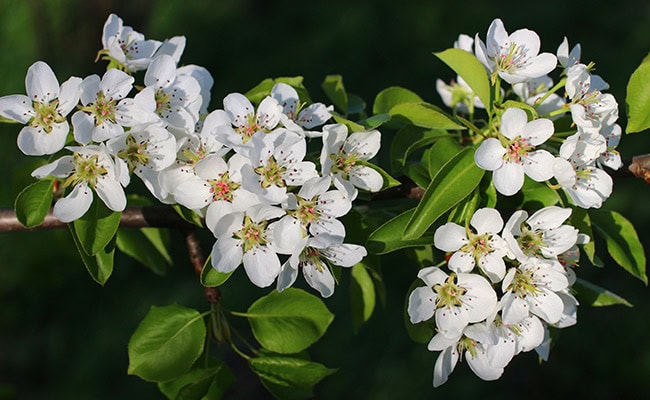
This moderately fragrant deciduous shrub or small tree is a member of the Rosaceae plant family, related to roses and many edible fruits such as apples, pears, and cherries. It symbolizes supreme happiness, hope, and even protection with its thorns.
Hawthorn has white or pink flowers in spring, including throughout May, and produces red berries in the fall that can make delicious jams, jellies, wine, syrups, and flavorings to enjoy the plant long after its symbolic month.
Whether you prefer lily of the valley or hawthorn, both plants can be stunning options for a family garden to share the beauty of May all year long.
Join The Discussion
Which may birth month flower do you prefer: lily of the valley or hawthorn?
Did anything surprise you about lily of the valley meaning?
Share your thoughts, tips, and tricks in the comments below!

Melissa Mayntz
Melissa Mayntz is a writer who specializes in birds and birding, though her work spans a wide range—from folklore to healthy living. Her first book, Migration: Exploring the Remarkable Journeys of Birds was published in 2020. Mayntz also writes for National Wildlife Magazine and The Spruce. Find her at MelissaMayntz.com.



